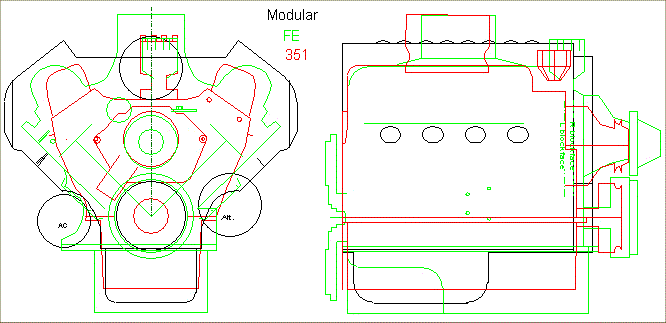Quote:
Originally Posted by Aussie Mike

We've got quite a few guys running them down here. We have a ready source of the quad cam 5.4 from our locally built Ford Falcon.
With our strict emissions laws it's now pretty much a choice between the 5.4 and the GM LS series engines. Due to it's gigantic proportions and mediocre performace the 5.4 seems to be the least popular option.
To give you an idea on difference in dimensions:

The 5.4 is even wider because of it's taller deck height over the 4.6. The only way these modular motors seem to be making any decent power is with forced induction.
I think their achilies heel is the bore spacing. Ford designed the motor with a really tight bore spacing to keep the motor length as short as possible for Front Wheel Drive applications. This put a cap on the max capacity of the motor such that to get to 5.4L they had to increase the stroke so much that the motor is undersquare (stroke longer than the bore size). It's a shame because they have these fantastic 4 Valve heads that have huge flow potential but a bottom end that won't do the revs to support them. I guess this is why the factory went for forced induction to increase displacement.
Cheers |
Well, you're comparing apples to oranges.
The stock vs stock argument, the new modulars kick the hell out of the old stuff. That war/fued went on for 10 years before the old pushrod folks would fully admit that the new modulars are by far a better engine. The heads and intake are better and when properly built, with higher compression and such, the modulars make great power.
Ford opted to go with the 5.4 (which as you pointed out is basically a stroked 4.6) because of the torque it produced and emissions. I think Ford will probably up their higher end plant next year to a 6 liter + to compete with the stuff Nissan and Toyota are putting out. But that will probably be the last "big" engine made by Ford. I think you'll see that Chrysler has peaked at the 8.3l and Chevy will not offer a 7.0 liter after next year (they're replacing it with a blown 6.x liter). So snatch up your Z06's and Vipers while you still can. 15 years from now they'll be collector classics as most if not all cars will be fully electric and the small minority that aren't will be hybrid.
All things considered, my 5.4 made 1300 horsepower stuffing it with 26 psi. Do the math and the theoretical base power for the engine is in the neighborhood of 433 horsepower. It's probably higher than that, considering the inefficiencies.
The 2000 cobra R featured a 5.4 and made 385 horses. That's pretty darn good for a 331 cubic inch motor. When taken to the max, it can make quite a bit of power (i.e. wicked cams and higher compression).
Consider that a 347 would have to make 403 horsepower and a 427 would have to make nearly 500 cubes to have the equivalent efficiencies.
That's not bad. Even in bone stock, OEM setup the 281 makes over 1 hp/cube and makes 1.13 pounds/cube. Not bad for an engine that passes emissions.
Compare these numbers to the days of the old 302s and you'll (stock) and you'll find that most old timers have rose colored glasses on. There were actually years where the mustang came with 140 hp.
The first of the big blocks was the 390 which made a whopping 320 hp (but with 427 torque).
The 428 cobra jet only made 400 horsepower (even with an oversized intake and an upgraded carb).
The Boss 429 was originally "rated" at 375 hp (although understated) but it was common for aftermarket guys to get 500 hp.
The original 351W which only made a whopping 285 hp. The Boss 351 made 330hp.
The venerable 302 which lasted the longest, started out making only 230 horsepower.
So you have to compare apples to apples. If you're going to compare engines and outputs, then compare stock vs. stock or built vs. built.
There are 281 ci modulars running well over the old 1hp/cube standard and approaching the 1hp/cc benchmark (race car territory).
These engines are VERY formidable when built properly. With modern forced induction, you don't have to run a giant displacement to make power...and without the loss of streetability or driving manners.
Just like stock 302s, the new modulars respond very well to induction improvements (better cams, port/polish, better compression, etc).
The new platform, both from production efficiencies, the marketplace, emissions, economy, etc, is to take a smaller engine and slap a blower/turbo on it. That way you have the base model and the performance model. You don't need two different manufacturing facilities. No need to sacrifice gas mileage or emission standards. Just slap a turbo on it and when you put put, you save gas, when you stomp stomp, you get up and go.
I'd venture that in 20 years, you may not be able to assemble a 400+ cubic inch engine into a vehicle unless it already had one in it.